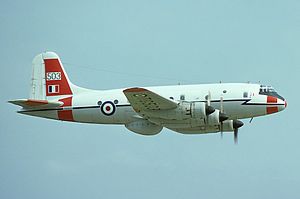Handley Page Hastings
| Hastings | |
|---|---|
 |
|
| Hastings TG503 in flight in June 1977 | |
| Role | Transport aircraft |
| Manufacturer | Handley Page |
| First flight | 7 May 1946 |
| Introduction | September 1948 |
| Retired | 1977 (RAF) |
| Primary users |
RAF RNZAF |
| Produced | 1947 – 1952 |
| Number built | 151 |
| Variants | Handley Page Hermes |
The Handley Page H.P.67 Hastings was a British troop-carrier and freight transport aircraft designed and built by the Handley Page Aircraft Company for the Royal Air Force. At the time, it was the largest transport plane ever designed for the RAF, and it replaced the Avro York as the standard long-range transport.
Handley Page's answer to meet Air Staff Specification C.3/44 for a long-range general purpose transport was the H.P.67. It was an all-metal low-wing cantilever monoplane with a conventional tail unit. It had all-metal tapering dihedral wings, which had been designed for the abandoned HP.66 bomber development of the Handley Page Halifax and a circular fuselage suitable for pressurisation up to 5.5 psi (38 kPa). It had a retractable undercarriage and tailwheel. The Hastings was powered by four wing-mounted Bristol Hercules 101 sleeve valve radial engines. In service, the aircraft was operated by a crew of five and could accommodate either 30 paratroopers, 32 stretchers and 28 sitting casualties, or 50 fully equipped troops.
A civilian version of the Hastings was developed as the Handley Page Hermes. The Hermes prototypes were given priority over the Hastings but that programme was put on hold after the prototype crashed on its first flight on 2 December 1945 and the company concentrated on the military Hastings variant. The first of two Hastings prototypes (TE580) flew at RAF Wittering on 7 May 1946. Tests showed that the aircraft was laterally unstable and that it had poor stall warning capabilities. The prototypes and first few production aircraft were subject to a series of urgent modifications and testing to resolve these problems. A temporary solution was found by modifying the tailplane with 15° of dihedral, while being fitted with synthetic stall warning. This allowed the first production aircraft (Hastings C1) to enter service in October 1948.
...
Wikipedia
